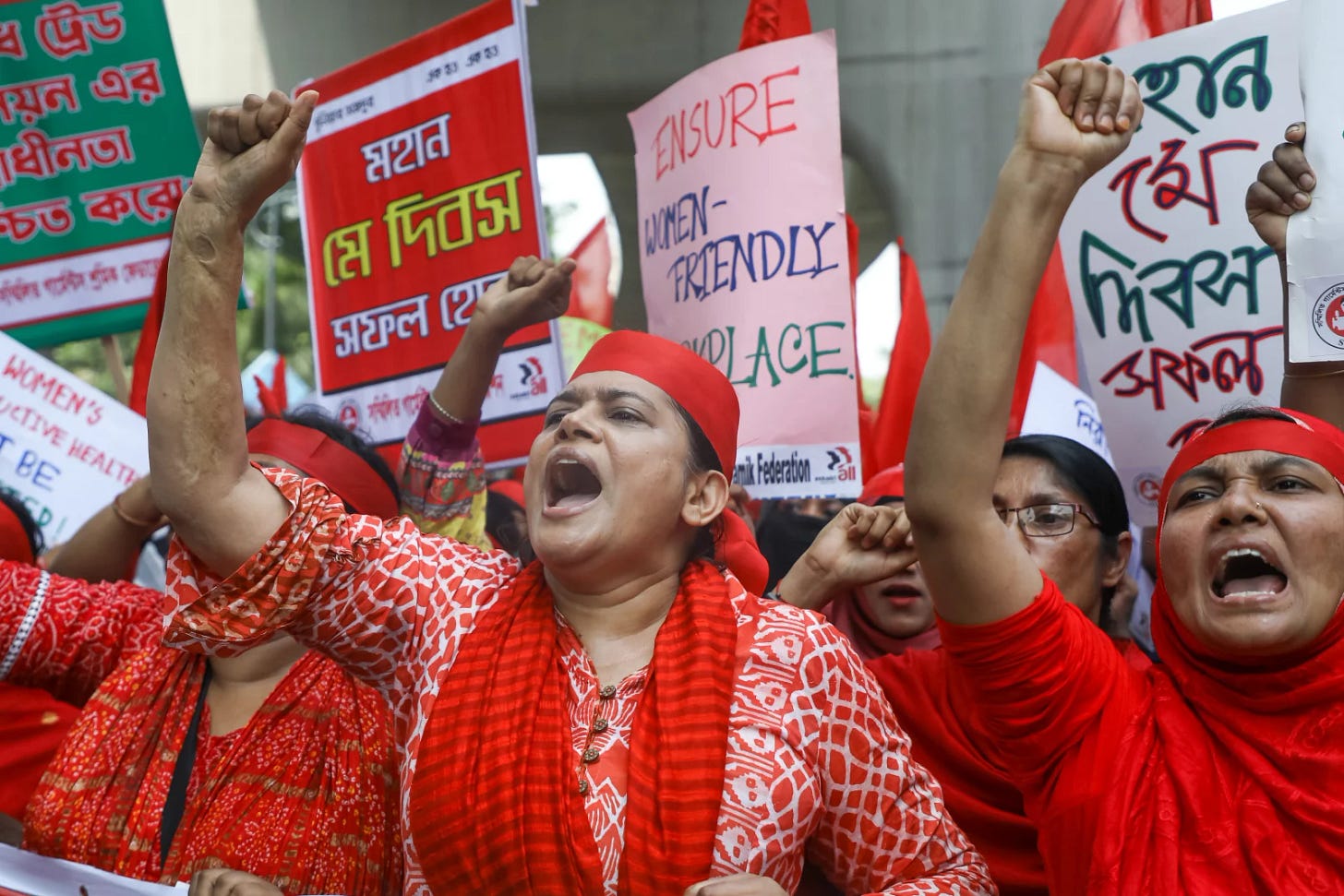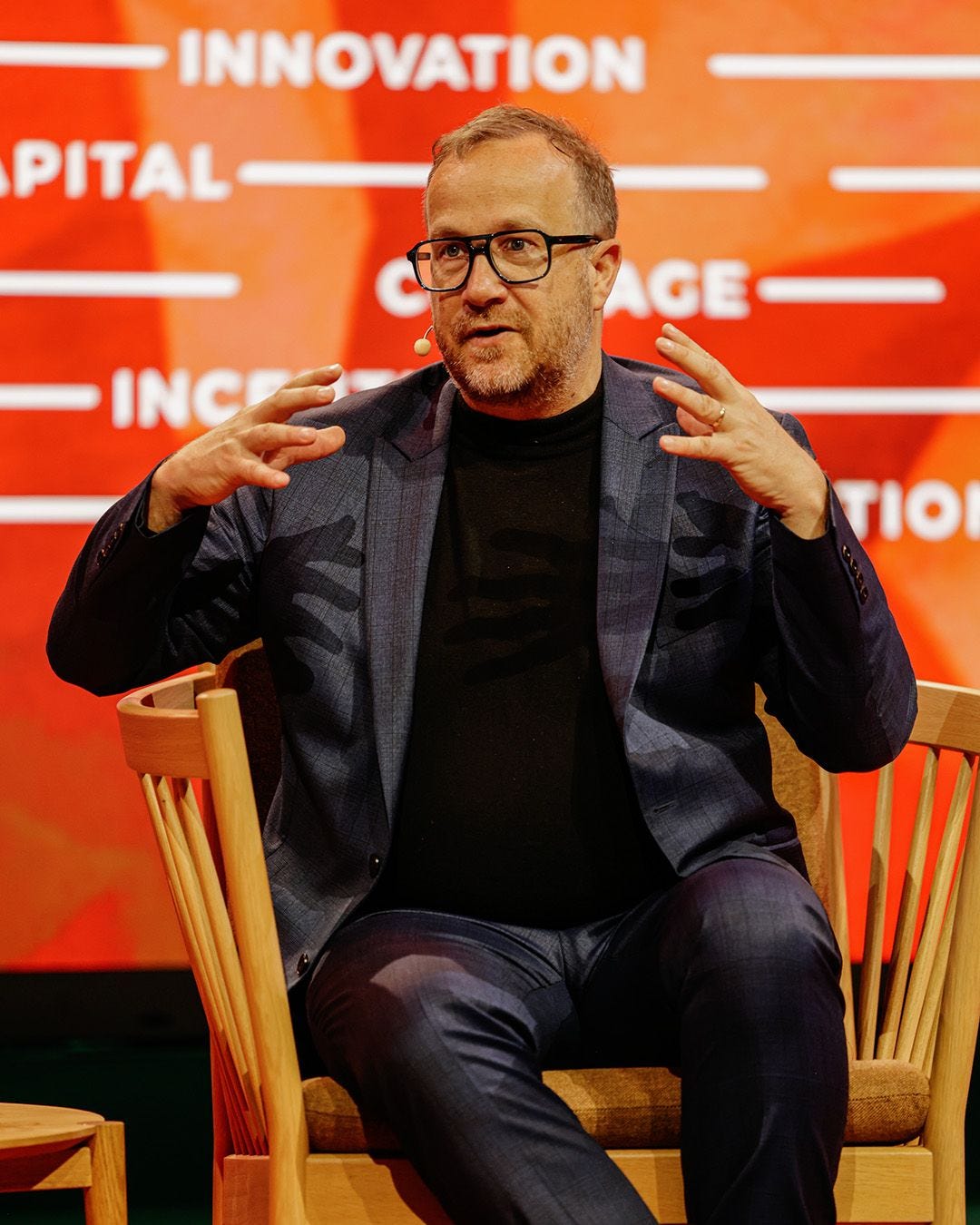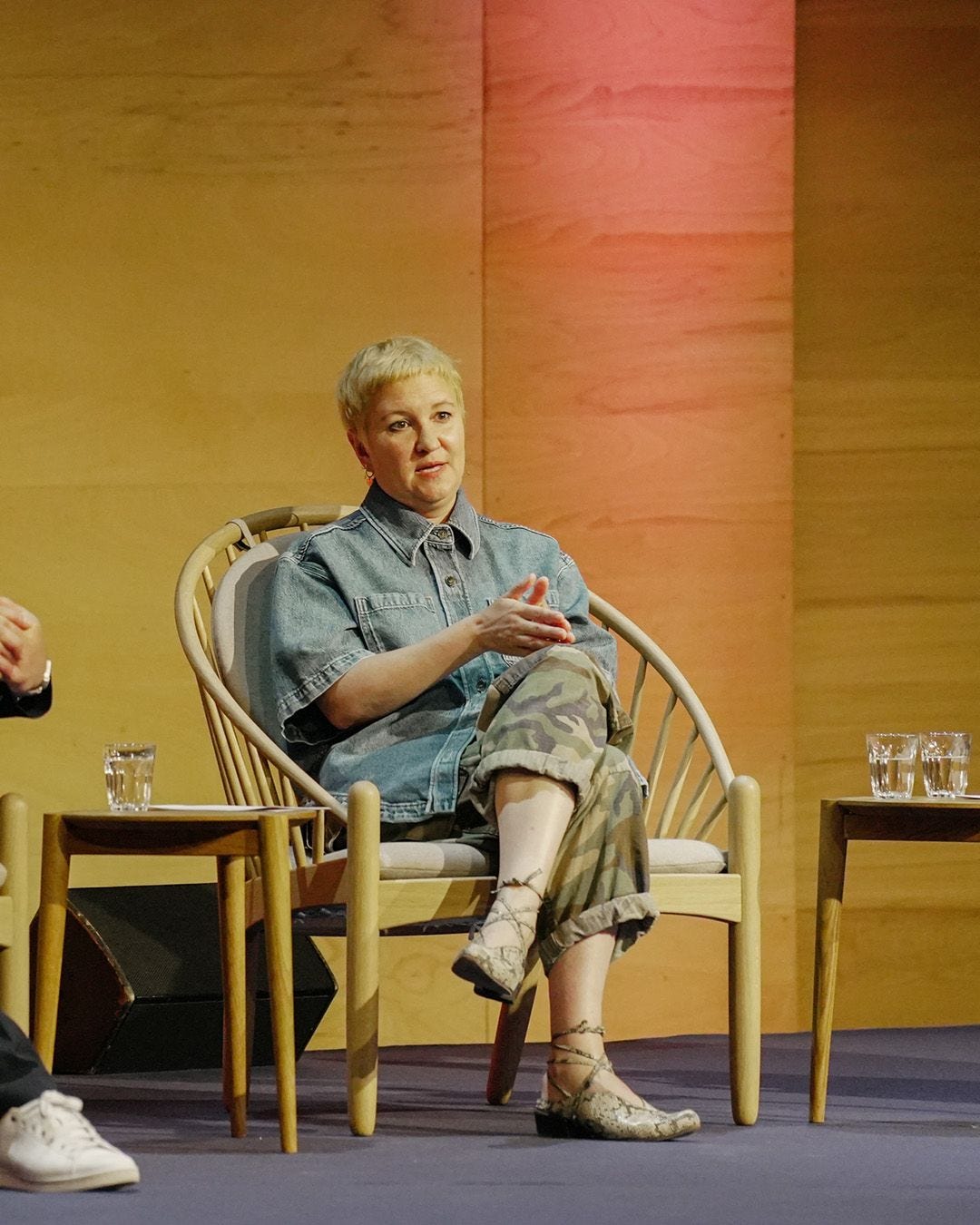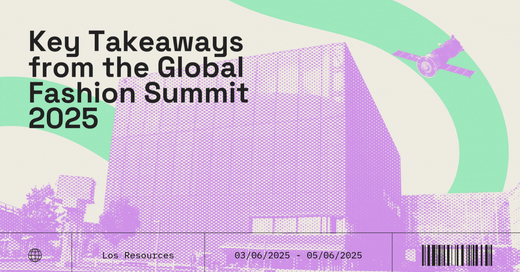Key Takeaways from the Global Fashion Summit 2025
Because it sucks when great conversations happen and you’re not in the room. Here are the key things to know from GFS 2025.
Tuesday and Wednesday night you would’ve found me in my pajamas on my sofa, glued to the white light from my computer, hanging on every word. I got sick, and unfortunately had to cancel my trip. But that wasn’t going to stop me from listening in (even if from my living room at 4 am).
First of all, amazing conversations were had. Some deep, some new.
Carbon tunnel vision was not a thing. We talked about water, adaptation, workers’ rights, nature, and circularity. Perhaps, one of the sustainability conferences where climate change did not take over 50% of the conversations. We talked about realities, aspirations, and barriers. We talked about emerging bridges, but, in my opinion, not deeply about real solutions.
Without further ado, here are the key takeaways from GFS 2025.
A Long Way to Go: Worker Rights and Human Dignity
If you know me, you know I have a soft spot for suppliers and their workers. During a session, numbers and perspectives were shared that should make every fashion executive uncomfortable.
The current reality? After protests that left four workers dead and hundreds imprisoned, Bangladesh’s minimum wage sits at 12,500 taka (roughly $113 per month) even though workers were demanding 23,000 taka (about $208), and the Global Living Wage Coalition calculates that Bangladesh workers need around $238/month to survive.

So, the current minimum wage isn’t enough, not when “35% of income goes to housing,” typically a 10x10 foot concrete room, often without windows.
Recent rollbacks from the EU, mainly on CSDDD, and USAID cuts are putting even more pressure on workers. Audits and new legislation aren’t enough.
What brands can do: Speak up about Omnibus Proposal and recent changes. Reassess purchasing practices. Demand fair pricing models across your supply chain. And don’t wait for regulations to act. Collaborate with suppliers on wage transparency.
PS: I have a great how-to guide on how an SME brand got its suppliers to pay a living wage. Subscribe to La Purpose Brand. 🫒
The Consumer Gap: Lost in Translation
Some shared consumer research: While 74% of European consumers say they want to dress more sustainably, 41% still cite price as a barrier.
But we all know the say-do gap. What was interesting to me was that a speaker shared that in 2021, consumers were overwhelmed by too much sustainability info. In 2025, it’s the opposite. They can’t find enough. They don’t know why one product is better than another. And this makes sense to me. From my consumer interviews, they think that Adidas is just as sustainable as Everlane. They cannot tell the difference.
(And while not mentioned during the summit: Only 20% of consumers believe brands’ sustainability claims.)
What works? Connecting sustainability to co-benefits, things consumers already care about. For instance, organic cotton presented as “softer and safer” for children. That’s what sells.
I think it almost allows us to think of this idea of the Trojan horse in terms of how we're employing language and what those levers are to make consumers act and respond.
With greenwashing regulations coming up, it is hard to use the “S word.” Not being able to say “sustainability” surely minimizes greenwashing risk, but also maximizes the risk of losing customers in the numbers. A speaker emphasized using real and hard data.
A speaker shared,
We can’t describe the future just with numbers. The future needs a story.
We need to move away from the “enlightenment fallacy,” the idea that more data will automatically drive better decisions.
I think the best approach is probably somewhere in the middle: storytelling, co-benefits, and hard data to back it up.

What brands can do: Shift messaging from “save the planet” to “this benefits you.” Also, make sustainability part of the product page, not a separate tab hidden under “Sustainability.” Bring creative, marketing, and sustainability teams together from day one. Tell stories that matter, and back them up with real data.
Policies: The Patchwork Reality
Forced labor enforcement will likely remain strong in the US thanks to its classification under Homeland Security. We are also seeing progress at the state level, where EPR (e.g., California, and New York coming up) and circularity legislation is being driven forward while federal regulation stalls.
Meanwhile, the EU’s ESPR (Ecodesign for Sustainable Products Regulation) is moving ahead, with textiles as a top priority.
We all know the impact of tariffs on sustainability, and are creating significant uncertainty for manufacturers. When tariffs fluctuate, brands become hesitant to make long-term sustainability investments in affected regions. But, one speaker floated the idea of using tariffs as a sustainability lever (such as lower import duties for lower-impact materials a la CBAM).
What brands can do: Get involved early in policy discussions. Join working groups. Advocate for policies that align with real sustainability, not just legal minimums.
Suppliers as Partners: The Human-Centered Approach to Traceability
As some of you may know, I work on using AI to make traceability super easy for both SME brands and suppliers. So, of course, this was my favorite session.

The key takeaway: most traceability work is done by suppliers, yet most tools are built for brands. Tools that create more work for the least-resourced actors aren’t solutions. They’re cost transfers.
We are making the people with the least power do the most work.
Brands often request the same data in slightly different formats, over and over again. This duplicative effort is exhausting for suppliers and inefficient for everyone.
Another theme: empathy design. Building traceability tools shouldn’t just be about compliance. They should work for real humans, for the factory manager with a full inbox, for the sourcing agent trying to meet a deadline, for the cotton ginner who doesn’t speak English. Good design means starting with those people, not your audit dashboard.
Interoperability came up again and again. Brands shouldn’t force suppliers to use five platforms. They should build or adopt tools that connect to others: APIs, integrations, or even shared standards that reduce rework.
And finally, meaningful incentives matter. Suppliers are tired of the stick. They want the carrot. Recognition, long-term partnerships and commitments, even financial investment, those are what make it worth the time.
What brands can do: Talk to your suppliers and find ways to use whatever information is already available. Focus on traceability solutions that make their lives easier. Advocate with associations and collaborate with other brands to come up with a standard data request. And, commit to more transparent suppliers effectively rewarding their efforts.
🫒 Fashion Can Be Responsible: Be Ready to be WOWed by Veja and EILEEN FISHER
Veja started when everyone was going into tech, but the founders went in the opposite direction. They went “old school” and “back to the land.” Veja pays Amazon rubber tappers 2–3x market price while keeping sneakers competitively priced. How?
They do not spend on advertising. Unlike others who spend “50-70%” of the cost of a single sneaker on advertising, Veja spends 0%.
The result? Growth from €5,000 to over €200Mn, driven by product quality and word-of-mouth.

EILEEN FISHER’s story is even more radical: intentional degrowth. When they felt like they were moving away from the simplicity and values they started with, they got together and figured out what to do. They purposefully decreased their revenue from nearly $500Mn down to under $300Mn.
(Also: Eileen Fisher Renew has collected 2Mn garments for resale or repair since 2009.)
What brands can do: Stop chasing volume. Rethink success. Grow impact, not just revenue. Decouple new volume from profitability.
Climate Adaptation: Time for Hard Truths
In Cambodia, 80% of garment factories exceed safe working temperatures during hot months. Fainting, illness, lost wages from climate disruption. It’s already happening.
Mitigation isn’t enough. We need to work on adaptation as well.
The physical stuff, reducing factory heat by 4–5°C, it’s straightforward. (…) Living wages, collective bargaining, and better housing all help workers survive climate stress.
This isn’t theoretical. Bangladesh also had record-breaking heat waves last year. Many hubs for garment manufacturing are in areas with large physical climate risks and low level of infrastructure for adaptation.
Side note on mitigation: Land scarcity limits solar in Bangladesh. Coal may provide more jobs and uses less land. Speakers discussing about building “Future Forward Factories” that consolidate multiple low-carbon innovations under one roof. One factory in development will reduce emissions and water use while manufacturing 3M+ yards per month.
Side note on regeneration: Regeneration was one of the most hopeful panels. But it also got real. There is a need to define regenerative agriculture based on outcomes, not fixed practices. That means tracking soil carbon, water retention, biodiversity, and farmer livelihoods, without assuming one-size-fits-all methods. Regeneration can’t scale unless we let local context shape the path.

What brands can do: Support factory-level adaptation and mitigation. Incorporate adaptation into climate strategy. Provide supplier incentives for temperature audits. Address climate risk not just through emissions targets but through actual investment. Make long-term sourcing commitments to incentivize electrification. Factor in supplier climate performance when awarding business. Advocate for public financing to de-risk sustainable infrastructure. Find ways to measure outcomes of regenerative programs. Co-create programs with suppliers, including farmers.
Mi Take: Not Enough, and Not Soon Enough
The solutions exist. Veja proves sustainable business models work. Eileen Fisher shows profitable degrowth is possible. Regenerative agriculture can improve margins while healing landscapes.
But here’s the uncomfortable question: can this be replicated? Scaled? Veja is privately owned, founder-led, operates with about 600 people, and has spent 20 years building direct relationships with suppliers. They don’t have investors demanding quarterly growth or shareholders expecting advertising-driven sales spikes.
Eileen Fisher operates similarly: privately owned, with no pressure for constant growth, able to make long-term decisions based on values rather than quarterly targets.
How many fashion brands can actually replicate these models? Can only companies that start committed to sustainability be on the right path? How about brands that are trying to make the changes? Well, H&M has made progress with 24% emissions reduction. But what about volume sold? Can H&M become a “sustainable,” or as we say these days, “responsible” brand?
One speaker shared,
I believe the biggest barrier to creating a more harmonious relationship with nature is our current and somewhat delusional approach to innovation. Most of it feels like we are putting Band-Aids on a fundamentally broken system. We can’t Frankenstein our way out. We invest enormous amounts of effort trying to get legacy corporations to transform, even when their business model is structurally incapable of change.
The tension is that we’re trying to bolt solutions onto a system designed for extraction, not regeneration. We’re asking public companies with quarterly growth mandates to operate like private, mission-driven enterprises. We’re demanding scale from innovations that no one is willing to pay premium for.
The real barrier isn’t technical or financial: it’s structural. The question isn’t whether sustainable fashion is possible. The question is whether we’re willing to fundamentally change the dynamics that created the problems in the first place.
We’re in one of the biggest paradigm shifts humanity has seen.
The old system isn’t broken, it’s working exactly as designed. The new system requires different design principles entirely.
Bonus: New tools Announced
1. Circular Transition Indicators (CTI) Sector Guidance for Textiles 2.0
Dropped by the World Business Council for Sustainable Development (WBCSD), this update offers a concrete methodology to assess circularity in textiles. It helps companies move past vague recycling goals and actually measure material loops, end-of-life fate, and system boundaries. In plain English: it tells you how circular you really are, and where your blind spots live.
2. The Fashion Impact Toolkit (FIT)
Developed through a collaboration between Aii, Textile Exchange, and Sustainable Apparel Coalition, this tool aims to streamline how brands conduct and report environmental impact assessments. It’s meant to reduce duplication, unify impact methods, and make it easier for suppliers and brands to align on what data actually matters. Think of it as a universal adapter for sustainability metrics.
Ready to break industry norms? Subscribe to La Purpose Brand 🫒. We're building a catalog for SME brands bold enough to change the industry.
Got feedback? I actually read these, so tell me what to tackle next.





